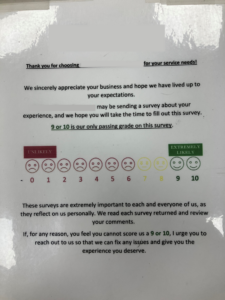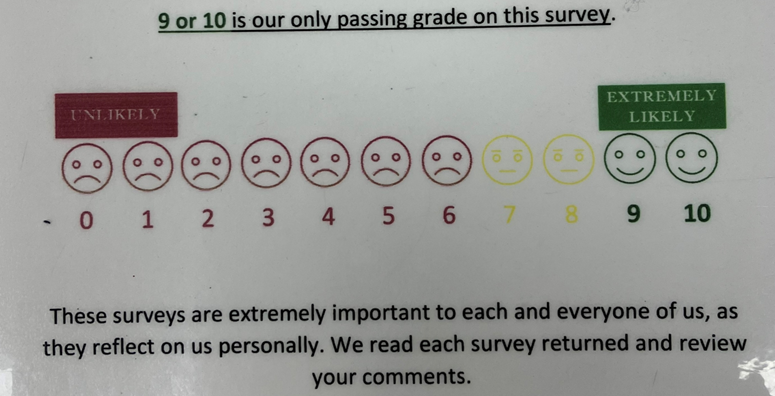Well-intentioned employees can save a client but miss big problems by gaming NPS
The Net Promoter Score (NPS) is an effective way to understand how likely customers are to recommend a business to others, revealing opportunities and improvement areas to senior management.
NPS relies on the answer to one simple question: “On a scale of 0 to 10, how likely are you to recommend COMPANY X?”
This willingness to recommend is more significant than satisfaction. A customer may be satisfied with a product or service, but they are putting their own credibility on the line if they’re willing to vouch for it and promote it to friends and colleagues.
The Net Promoter Score has become such a crucial metric that it is now the go-to measure most companies use to gauge their performance with clients and customers quickly. According to this recent article (link may require subscription), two-thirds of companies use NPS to help guide their strategy.
As NPS has become more widespread, many front-line workers and managers understand that it is an important measure but don’t understand when, how, and why it’s used.
We have seen executive leadership using (and misusing) scores to reward or punish workers. These workers will, in turn, try to game the NPS of the people they survey to make themselves look good to the executives who deployed the NPS in the first place. These incentives to game NPS scores can lead to inaccurate or biased results.
Winning Battles, Losing Wars

Bias, or outright NPS inflation, can be problematic when front-line individuals or branches collect these scores.
The image, above, came from a local car dealer with this laminated sheet near their checkout counter, encouraging customers to let them know if they planned on giving a low score/NPS rating.
Although it’s essential for companies to identify opportunities to improve the experience for dissatisfied customers, trying to raise NPS scores on a one-off basis can confound the results.
While this policy may help the car dealer succeed in retaining a customer here and there, their efforts may obscure a more significant structural problem within their business – one that caused the negative interaction in the first place.
In doing so, they may delay recognition and resolution of the underlying problem, lowering the quality of the customer experience across the entire company.
An Oily Practice
Sticking with our car dealer, a hypothetical customer might intend to provide a low score after their oil change because their car was leaking oil. The dealer might talk the customer into providing a higher score with the promise of several free oil changes going forward. However, by artificially raising the NPS of this customer, the dealer might delay executive leadership discovering that the company had been shipping poor oil filters or, perhaps, that better training was required for the technicians providing oil changes for a particular model of automobile.
It’s likely that this specific dealer thought that a bad score would reflect negatively on the branch – either because managers there misunderstood how NPS was being used or, worse, because senior executives were punishing dealers with lower NPS scores.
The example above is made up, but it’s obvious that this company needs to improve communication between senior executives at headquarters and dealers about the goals of the NPS survey project.
When NPS is being used correctly, the goals of NPS programs are to create a systematic improvement firmwide – not to punish an individual employee for a low score in a single interaction.
Conversely, if the NPS program has unclear goals, or is being used to incentivize or punish employees for individual customer interactions, it will be hard to discourage front-line staff from trying to manage (or game) the scores.
It’s Hard to Avoid Bias
NPS relies on the answer to one simple question, but getting a good understanding of NPS is not simple.
Obtaining unbiased customer feedback is essential for gaining critical insights into your growth plans, as only they can provide honest feedback about your products and services. However, customers may hesitate to reveal the hard truth, and poorly structured questions or collection techniques may render the information unusable.
Topline Strategy’s Voice of the Customer program utilizes our Strategic NPS methodology, leveraging our advantage as an unbiased third party to extract typically inaccessible feedback to the company. Voice of the Customer goes beyond standard customer satisfaction or NPS programs that focus solely on operational issues and use online surveys to develop quantitative metrics.
Learn more about stacking your company’s NPS against other firms in your sector.
Or
See how NPS and Voice of the Customer research could benefit your business.
Contact us to discuss.

